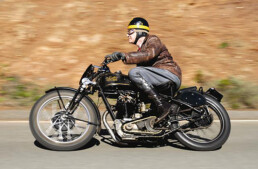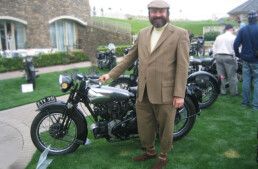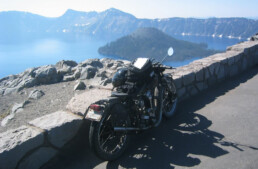New York City has its own brand of summer heat, and in July it becomes brutally hot and sticky. For those in the know, old garages with thick cement walls remain cool in the summer, and become zones of refuge for those who wrench on cars and bikes. It’s a side benefit of being a gearhead during the summer. Craig Hoffman’s garage is such a refuge – open by invitation only. His sensibility about high performance cars and motorcycles is an accumulation of experience that is very personal and very private.














Ahhhh … nice to know places like this still exist in overly gentrified NYC .
And hey … there it is ! ( or at least one like it ) A 1965 Olds F85 4-4-2 … take the hood scoop off .. replace it with a shaved and molded ( moi ) hood … stuff a 69 Olds built balanced and blueprinted 455 underneath … paint it midnight blue … with just a hint of a dark burgundy pinstripe job . a slight rake .. .and the coupes de gras … widened steel wheels w/ stock hubcaps bolted in … ( maintaining that whole ‘ sleeper ‘ vibe ) .. call it the Midnight Rider .. w/ moniker on back .. in said dark burgundy of course … and you’ve got my old Olds ride … beep beep zip take that Road Runner ! .. thanks to my hard work as a teen along with my two great uncles ( one had an engine shop .. the other a body shop )
Ahhh … them were the days … wouldn’t do it now to save my life … but sure as hell glad I did it then .. back when the junkyards and race shops were sources for used parts for pennies on the dollar … making such a venture doable if you were willing to put in the work .
For some reason NY had all these specialty high schools throughout Manhattan and the boroughs.I havent seen anything like it in any other US city.
Into cars?Theres Automotive High in Bklyn
Airplanes?Aviation out by LaGuardia
Printer?Printing Trades in Manhattan
Engineers:Brooklyn Tech
Artist:Music and Art or Art and Design
Merchant Seaman:John Brown
Actor:Performing Arts High
Cosmetology,Garment Trades…
Ahhh .. so yer not aware of the realities of the education system of old in the TriState ( NY NJ PA ) area … where shop .. as in all forms of shop classes .. were not only on offer through out the school systems … but in most cases were mandatory ( up until the mid 70’s ) for ALL Jr High and H.S. students regardless of what ‘ track ‘ ( higher ed – the trades etc ) you were on .
So yeah … I had to take one full year each of WoodShop .. AutoShop .. Technical Drawing ( precursor to architectural drawing ) . Metal Shop and Appliance Maintenance Shop … despite being on a Uni / Music Conservatory track .
And truth be known .. I’m damn glad I did .. watching the post 70’s generations of today unable to so much as lift the hood of their car .. never mind actually repair it !
That was the benefit of all those high taxes you paid for the privilege of living there back then . Your kids walked away regardless of what their future had in store well rounded and able to build , fix and repair their cars .. homes .. tv’s .. etc not to mention make a few goodies rather than buy them .. as well as move on to higher ed if that was their goal .
THAT … good sir was ( as in the distant past ) the reality of growing up during the 50s 60s 70s in the Beast that is the East TriState area . You walked out with a H.S . diploma and the ability to DO things … rather than just buy things .
As for all the post H.S. trade schools ? Every state had ( as in the past ) those .. in order to fill the jobs that are needed … but unlike every other state … the TriState area prepared you well for those trader schools assuming that was the route you choose .
The arts High Schools ? That was a product of an upper class willing to finance the education of youth for the arts in order to maintain and sustain the thing they all loved back then … the arts . Fortunately most have deep enough pockets endowment wise to continue functioning despite what the Far Never Right might want …
So good sir … there’s yer answer .. the Clip Notes version … but the answer never the less
Cheers … hope all is well down under … cause things sure is a ( bleeping ) mess over this way ..
😎
I didnt know public high schools could be endowed by rich people
Great article Michael ! Not necessarily motorcycle related but great all the same. Ah to be able go back to the days of our youth when fast cars and speed parts were all we spent our hard earned money on. Thank you for the trip to yesteryear. The recent passing of Ozzy and stumbling onto your story has made the past week a trip back to my youth, if only in my memory.